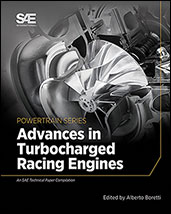Technical Paper
A High Efficiency Small Internal Combustion Engine for the Production of Electricity Onboard Electric Vehicles
2021-09-22
2021-26-0162
A combustion fuel tank, an internal combustion engine (ICE), and a generator provide the best opportunity to store extra energy onboard battery electric vehicles (BEV). This energy may be used for on-demand electricity production when needed, for example, rural or interstate driving. Specific to this work, the design of a high-efficiency ICE that works at a single speed and a single load, continuously, during the operation of this series hybrid vehicle is considered. The ICE and generator provide a fuel conversion efficiency chemical to electric η~50%. The series hybrid vehicle may deliver miles-per-gallon-of-gasoline (MPG) 13% better than current production plug-in hybrid electric vehicles (PHEV), and miles-per-gallon-of-gasoline-equivalent (MPGe) 12% better than the BEV of the same platform with a larger battery pack to permit capital cities commuting.


